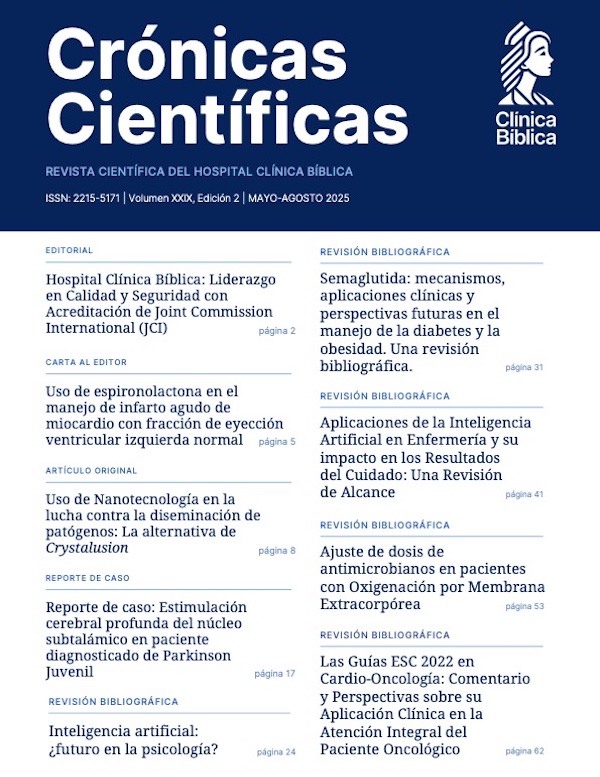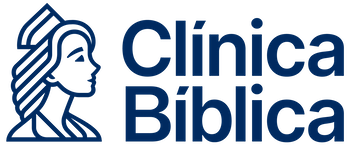- Visto: 1188
Colesteatoma: Etiopatogenia, hallazgos clínicos, métodos diagnósticos y manejo
Cholesteatoma: Etiopathogenesis, clinical findings, diagnostic methods and management
Edición XXIV Mayo - Agosto 2023
DOI: https://doi.org/10.55139/SCPL5208
APA (7ª edición)
Martén Sáenz, M. C., Waugh Chacón, S., & Valverde Solano, S. (2023). Colesteatoma: Etiopatogenia, hallazgos clínicos, métodos diagnósticos y manejo. Crónicas científicas, 24(24), 1-8. https://doi.org/10.55139/SCPL5208.
Vancouver
Martén Sáenz MC, Waugh Chacón S, Valverde Solano S. Colesteatoma: Etiopatogenia, hallazgos clínicos, métodos diagnósticos y manejo. Cron cient. 1 de agosto de 2023;24(24):1-8.
Dra. María Catalina Martén Sáenz
Médico general, graduada de la Universidad de Ciencias Médicas (UCIMED)
Investigadora independiente, San José, Costa Rica.
Dr. Sebastian Waugh Chacón
Médico general, graduado de la Universidad de Costa Rica (UCR)
Investigador independiente, San José, Costa Rica.
Dra. Sofía Valverde Solano
Médico general, graduada de la Universidad de Ciencias Médicas (UCIMED)
Investigadora independiente, San José, Costa Rica.
Resumen
El colesteatoma es una enfermedad benigna de caracterizada por un crecimiento de epitelio estratificado queratinizante en forma de quiste con capacidad invasiva localizado en el oido medio. La fisiopatología aún no está completamente descubierta sin embargo la teoría más fundamentada explica que se originan tras la disfunción en la trompa de Eustaquio que ocasiona un fenómeno de vacío en el oido medio con retracción de la membrana timpánica provocando que el epitelio escamoso que la recubre se acumule en forma de quiste expansivo.
Esta es una enfermedad de crecimiento progresivo por lo que puede cursar asintomática y progresar a síntomas como hipoacusia conductiva u otorrea hasta síntomas de invasión local como tinitus, vértigo, parálisis facial o abscesos cerebrales. A la otoscopía se visualiza como una masa billante, blanquecina y compresible. Su manejo es meramente quirúrgico con el propósito de disecar por completo la lesión y mejorar la audición del paciente.
Palabras claves
Colesteatoma, clasificación, colesteatoma congénito, colesteatoma adquirido, mastoidectomía abierta, mastoidectomía cerrada.
Abstract
Cholesteatoma is a benign disease characterized by a growth of keratinizing stratified epithelium in the form of a cyst with invasive capacity located in the middle ear. The pathophysiology is not yet fully discovered, however the most fundamental theory explains that they originate after Eustachian tube dysfunction that causes a vacuum phenomenon in the middle ear with retraction of the tympanic membrane, causing the squamous epithelium that covers it to shrink. accumulate in the form of an expanding cyst. This is a disease of progressive growth, so it can be asymptomatic and progress to symptoms such as conductive hearing loss or otorrhea to symptoms of local invasion such as tinnitus, vertigo, facial paralysis or brain abscesses. On otoscopy it is visualized as a shiny, whitish and compressible mass. Its management is purely surgical with the purpose of completely dissecting the lesion and improving the patient's hearing.
Keywords
Cholesteatoma, classification, congenital cholesteatoma, acquired cholesteatoma, open mastoidectomy, closed mastoidectomy.
Bibliografía
1. Castle J. Cholesteatoma Pearls: Practical Points and Update. Estados Unidos: Springer; 2018.
2. Isaacson G. Cholesteatoma in children. Up to date; 2022.
3. Wei B, Zhou P, Zheng Y, Zhao Y, Li T, Zheng Y. Congenital cholesteatoma clinical and surgical management. Int J Pediatr Otorhinolaryngol; 2023.
4. Reuven Y, Raveh E, Ulanovski D, Hilly O, Kornreich L, Sokolov M. Congenital cholesteatoma: Clinical features and surgical outcomes. Int J Pediatr Otorhinolaryngol; 2022.
5. Olmedo J, Ropero F, Sánchez S. Cholesteatoma: Influence of surgical technique and EAONO/JOS stage on audiological results. Acta Otorrinolaringol Esp (Engl Ed); 2021.
6. Casazza G, Carlson ML, Shelton C, Gurgel RK. The Medially-Invasive Cholesteatoma: An Aggressive Subtype of a Common Pathology. Ann Otol Rhinol Laryngol. 2021.
7. Schurmann M, Goon P, Sudhoff H. Review of potential medical treatments for middle ear cholesteatoma. Cell Commun Signal; 2022.
8. LustingL,LimbC,DurandM. Chronicotitismediaandcholesteatomainadults. Uptodate; 2023.
9. Orobello N, Harrington C, Reilly BK. Updates in paediatric cholesteatoma. Curr Opin Otolaryngol Head Neck Surg. 2022.
10. Hermann R, Blanc J, Fieux M, Desternes G, Coudert A, Truy E. Multi-operated cholesteatoma: when two surgeries are not enough. Eur Arch Otorhinolaryngol. 2021.
11. Rohlfing ML, Sukys JM, Poe D, Grundfast KM. Bilateral congenital cholesteatoma: A case report and review of the literature. Int J Pediatr Otorhinolaryngol. 2018.
12. Galal A, ElNaggar M, Omran A, Eid M, Badr-ElDine M. Fusion of DiffusionWeighted Magnetic Resonance Imaging and High-Resolution Computed Tomography Scan As a Preoperative Tool for Classification of Middle Ear Cholesteatoma. J Int Adv Otol. 2022.
13. Jackson R, Addison AB, Prinsley PR. Cholesteatoma in children and adults: are there really any differences? J Laryngol Otol. 2018.
14. Chiao W, Chieffe D, Fina M. Endoscopic Management of Primary Acquired Cholesteatoma. Otolaryngol Clin North Am. 2021.
15. Saxby AJ, Jufas N, Kong JHK, Newey A, Pitman AG, Patel NP. Novel Radiologic Approaches for Cholesteatoma Detection: Implications for Endoscopic Ear Surgery. Otolaryngol Clin North Am. 2021.
APA (7ª edición)
Martén Sáenz, M. C., Waugh Chacón, S., & Valverde Solano, S. (2023). Colesteatoma: Etiopatogenia, hallazgos clínicos, métodos diagnósticos y manejo. Crónicas científicas, 24(24), 1-8. https://doi.org/10.55139/SCPL5208.
Vancouver
Martén Sáenz MC, Waugh Chacón S, Valverde Solano S. Colesteatoma: Etiopatogenia, hallazgos clínicos, métodos diagnósticos y manejo. Cron cient. 1 de agosto de 2023;24(24):1-8.
Esta obra está bajo una licencia internacional Creative Commons: Atribución-NoComercial-CompartirIgual 4.0 Internacional (CC BY-NC-SA 4.0)

Realizar búsqueda
Última Edición
Ediciones






